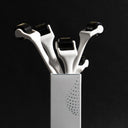For individuals seeking to combat hair loss and promote hair growth, microneedling with a derma roller has emerged as an increasingly popular and effective option. These handheld devices, equipped with tiny needles, create micro-injuries on the scalp, stimulating the body's natural healing response and potentially enhancing blood flow and hair follicle activity. However, selecting the appropriate derma roller size is crucial for achieving optimal results while minimizing potential risks or discomfort.
Table of content
Which derma roller size is best for hair growth?
For hair growth purposes, most experts recommend using a derma roller with needle lengths ranging from 0.5 mm to 1.5 mm. The ideal size can vary depending on individual factors, such as scalp sensitivity, hair type, and the specific area being treated. However, the 1.0 mm derma roller is often considered the sweet spot that balances effectiveness and safety for many individuals.
Here's a breakdown of the most commonly recommended derma roller sizes for hair growth:
0.5 mm
A 0.5 mm derma roller is generally considered the safest and most gentle option for those new to microneedling or with sensitive scalps. This size is suitable for beginners and can help the scalp gradually adjust to the treatment. While it may be less effective for promoting significant hair growth, it can still provide some benefits in terms of scalp stimulation and improved absorption of topical products.
1.0 mm
A 1.0 mm derma roller is often regarded as the sweet spot for hair growth purposes. This size is deep enough to create micro-injuries that stimulate the scalp and hair follicles effectively, while still being relatively safe and well-tolerated by most individuals. Many users report noticeable improvements in hair growth and density when using a 1.0 mm derma roller consistently.
1.5 mm
For those with more stubborn hair loss or thinning, or for individuals with thicker scalp skin, a 1.5 mm derma roller may be recommended. This size can penetrate deeper into the scalp, creating more substantial micro-injuries and potentially leading to more significant hair growth. However, it is essential to exercise caution with longer needles, as they can increase the risk of discomfort, bleeding, or potential scarring if not used properly.
As your leading source for hair health information over the past 4 years, we never compromise on accuracy. When it comes to your health, you deserve information you can truly rely on - and earning your trust is our top priority.
Here's how Scandinavian Biolabs ensures every piece of content meets the highest standards of accuracy and integrity:
- Credentialed Experts: Our reviewers are actively practicing doctors and medical researchers
- Stringent Reviews: Content undergoes rigorous editing by subject specialists and review by a practicing doctor.
- Evidence-Based: We rely on well-established research from trusted scientific sources like peer-reviewed journals and health authorities.
- Full Transparency: Our editorial standards, writer credentials, reviewer credentials, correction process, and funding are all publicly documented.
- Independent Voice: While we do promote products, we operate in a vacuum to business operations. Our main goal is just an unwavering commitment to providing medically-sound guidance.
You can count on Scandinavian Biolabs to consistently deliver the trustworthy health information you deserve. Read our Editorial Standards.
Factors to Consider When Choosing Derma Roller Size
Scalp Sensitivity
Individuals with sensitive scalps or those prone to irritation may want to start with a smaller size, such as 0.5 mm, and gradually increase as their scalp becomes accustomed to the treatment. Larger needle sizes can cause more discomfort and potential side effects in sensitive individuals.
Hair Type and Density
Those with thicker or coarser hair may benefit from larger derma roller sizes, as the needles need to penetrate through the hair strands to reach the scalp effectively. Those with finer or thinner hair may find smaller sizes more suitable.
Treatment Area
When treating specific areas, such as the hairline or crown, smaller derma roller sizes may be preferred to avoid excessive trauma or discomfort in these more delicate regions.
Experience Level
Beginners to microneedling should start with smaller derma roller sizes (0.5 mm or 1.0 mm) and gradually increase as they become more comfortable with the technique and their scalp's tolerance.
Additional Considerations
Proper Technique
Regardless of the derma roller size chosen, it's essential to follow proper microneedling techniques to ensure safety and effectiveness. This includes sterilizing the device before and after use, applying gentle pressure, and avoiding excessive trauma to the scalp.
Combining with Topical Treatments
Many experts suggest combining the use of a derma roller with topical hair growth serums or treatments containing ingredients like minoxidil or other proven hair growth compounds. The micro-channels created by the needles can help enhance the absorption and effectiveness of these products.
Consistency and Patience
Hair growth is a gradual process, and results may not be immediately apparent. It's essential to be patient and consistent with your derma roller routine, as results can take several months to become visible. Stick with the recommended size and follow the proper guidelines for optimal outcomes.
While selecting the appropriate derma roller size is important, it's equally crucial to manage your expectations and consult with a dermatologist or trichologist if you have any specific concerns or conditions. They can provide personalized guidance and ensure the proper use of the device for your individual needs.
Tired of thinning hair holding you back?
Fight back with the medical-grade Scandinavian Biolabs Scalp Activation Derma Roller.
This isn't just any derma roller - it's packed with 540 medical-grade titanium needles designed to awaken dormant hair follicles and trigger thicker, healthier hair growth.
Imagine: a fuller head of hair you can be confident about.
And the best part? It's easy to use. Just roll it gently over your scalp once a week, even on wet hair. It's painless and works with your existing routine.
Don't waste another day with lifeless hair. Invest in your confidence with the Scalp Activation Derma Roller. Get yours today and watch your hair transform!
Read more:





